这里写自定义目录标题
一、红黑树概念及性质1. 概念2. 性质 二、红黑树的实现1. 红黑树节点的定义2. 红黑树的定义3. 红黑树的插入4. 红黑树的验证5. 红黑树相关的接口方法 三、用红黑树封装 map/set1. 红黑树的迭代器2. 改造红黑树3. 用红黑树封装 set4. 用红黑树封装 map
一、红黑树概念及性质
1. 概念
红黑树,是一种二叉搜索树,但在每个结点上增加一个存储位表示结点的颜色,可以是 Red 或 Black.
通过对任何一条从根到叶子的路径上各个结点着色方式的限制,红黑树确保没有一条路径会比其他路径长出两倍,因而是接近平衡的;如下图:
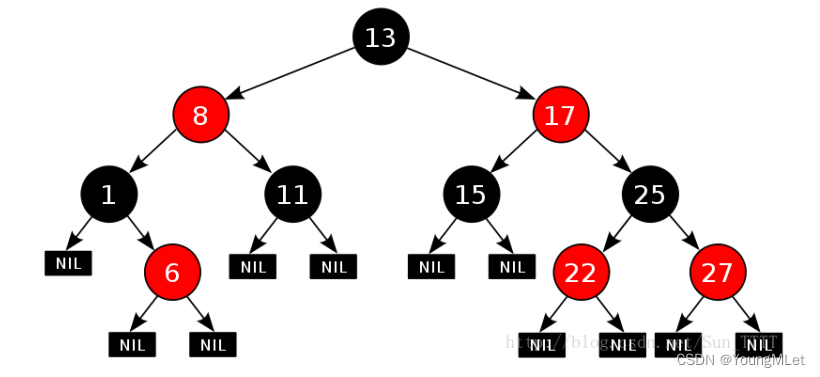
2. 性质
每个结点不是红色就是黑色;根节点是黑色的;如果一个节点是红色的,则它的两个孩子结点是黑色的;即不能有连续的红色节点;对于每个结点,从该结点到其所有后代叶结点的简单路径上,均包含相同数目的黑色结点;每个叶子结点都是黑色的(此处的叶子结点指的是空结点)为什么满足上面的性质,红黑树就能保证:其最长路径中节点个数不会超过最短路径节点个数的两倍呢?
很简单,假设每条路径的黑色节点数量为 h 个,那么 h <= 红黑树中任意一条路径长度 <= 2h;那么最短路径就是 h,即这条路径上全是黑色节点;最长路径是 2h,这条路径上全是一黑一红间隔;
如下图,左边是这颗红黑树的最短路径,高度为 2;最右边是这颗红黑树的最长路径,高度为 4;这颗红黑树中符合上面的所有规则,所以最短路径没有超过最长路径的两倍,所以这颗树符合红黑树的规则。
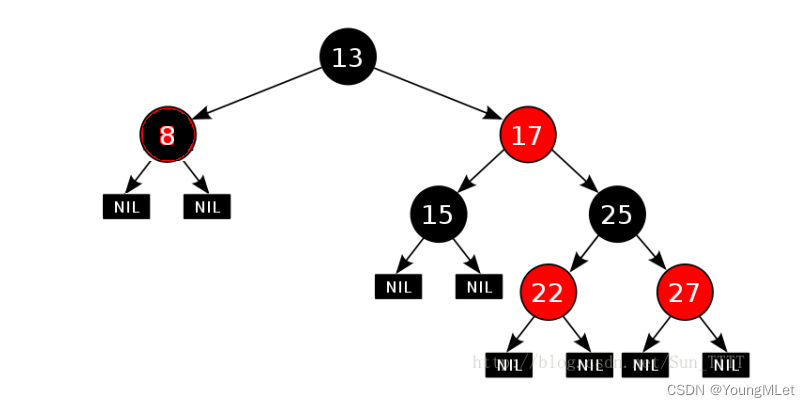
二、红黑树的实现
1. 红黑树节点的定义
想要实现一颗红黑树 ,首先我们得有树的节点,而树的节点中我们需要存:该节点的父节点、该节点的右孩子、该节点的左孩子、树节点的颜色以及数据类型;代码如下:
enum COLOUR{RED,BLACK};template<class K, class V>struct RBTreeNode{RBTreeNode<K, V>* _parent;RBTreeNode<K, V>* _left;RBTreeNode<K, V>* _right;COLOUR _col;pair<K, V> _kv;RBTreeNode(const pair<K, V>& kv):_parent(nullptr),_left(nullptr),_right(nullptr),_kv(kv),_col(RED){}};这里在节点的定义中,要将节点的默认颜色给成红色,这个后面再介绍。
2. 红黑树的定义
红黑树的定义如下:
template<class K, class V>class RBTree{typedef RBTreeNode<K, V> Node;private:Node* _root = nullptr;};3. 红黑树的插入
红黑树是在二叉搜索树的基础上加上其平衡限制条件,因此红黑树的插入可分为两步:
按照二叉搜索树的规则插入新节点代码如下:
bool Insert(const pair<K, V>& kv){if (_root == nullptr){_root = new Node(kv);_root->_col = BLACK;return true;}// 找到插入位置Node* cur = _root, *parent = nullptr;while (cur){if (cur->_kv.first > kv.first){parent = cur;cur = cur->_left;}else if (cur->_kv.first < kv.first){parent = cur;cur = cur->_right;}else{return false;}}cur = new Node(kv);if (parent->_kv.first > cur->_kv.first){parent->_left = cur;}else{parent->_right = cur;}cur->_parent = parent;}上面节点的定义中,我们默认给节点的颜色是红色,为什么是红色呢?因为如果给黑色,那么影响的将会是整棵树,新增黑节点的路径多了一个黑色节点,那么其它全部路径都会受到影响,影响面太大。
如果是新增的是红色节点,那么就要看其父节点,如果父节点是黑色的,那么就结束了;如果父节点也是红色的,那么违反了有连续的红色节点,只需要处理一下当前路径即可;所以默认新增节点为红色。
因为新节点的默认颜色是红色,因此:如果其父节点的颜色是黑色,没有违反红黑树任何性质,则不需要调整;但当新插入节点的父节点颜色为红色时,就违反了性质三不能有连在一起的红色节点,此时需要对红黑树分情况来讨论:
此时关键是要看叔叔(uncle)节点,因为当新增节点的父节点 parent 为红色的时候,如果 uncle 也是红色的,那么就让 parent 和 uncle 一起变黑色即可;如果 uncle 是黑色或者不存在,再另外讨论。
约定:cur 为当前节点,p 为父节点,g 为祖父节点,u 为叔叔节点
情况一: cur为红,p为红,g为黑,u存在且为红如下图:
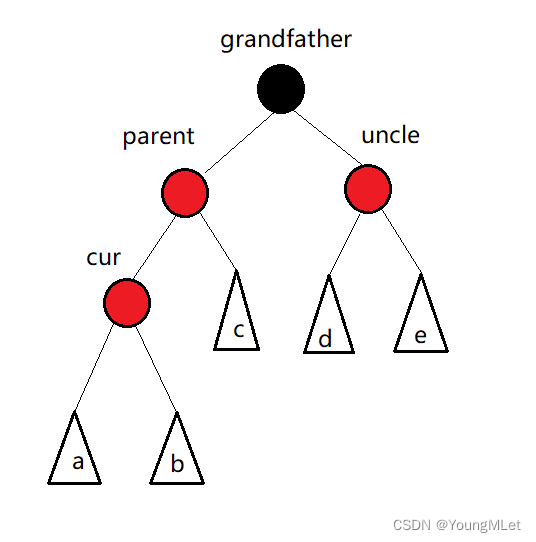
此时 a、b、c、d、e 都为符合规则的红黑子树,如果当 a、b、c、d、e 都为空,那么 cur 就是新增节点;否则,cur 就是从下面的子树中更新上来的。
上图中的情况,只需要变色处理即可,如下图所示,将 g 变红,p 和 u 变黑;如果 g 是根节点,最后还要把根节点变黑;如果 g 不是根节点,还要继续往上更新:
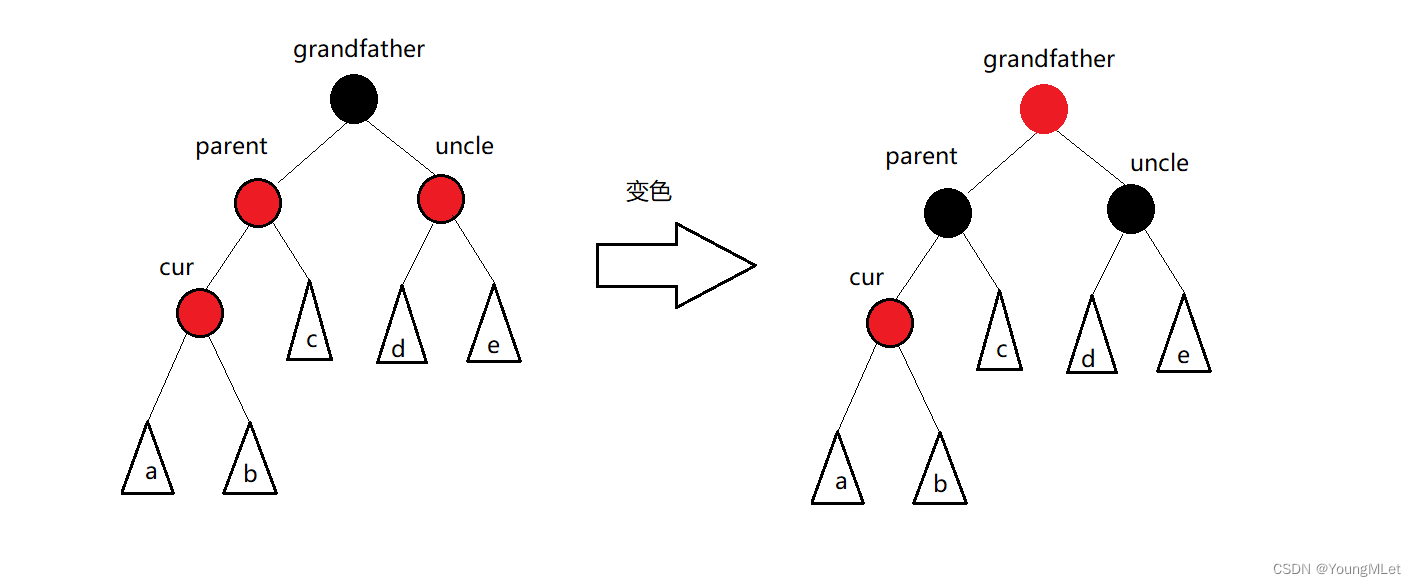
代码如下:
while (parent && parent->_col == RED){Node* grandfather = parent->_parent;// g// p u// cif (grandfather->_left == parent){Node* uncle = grandfather->_right;// 情况1、uncle 存在且为红// 不需要旋转if (uncle && uncle->_col == RED){// 变色parent->_col = BLACK;uncle->_col = BLACK;grandfather->_col = RED;// 继续往上更新处理cur = grandfather;parent = cur->_parent;}}}与上面情况相同但是 p 在 g 的右边的时候,如下图所示:

此时的处理情况与上面的处理情况一样,如下图:
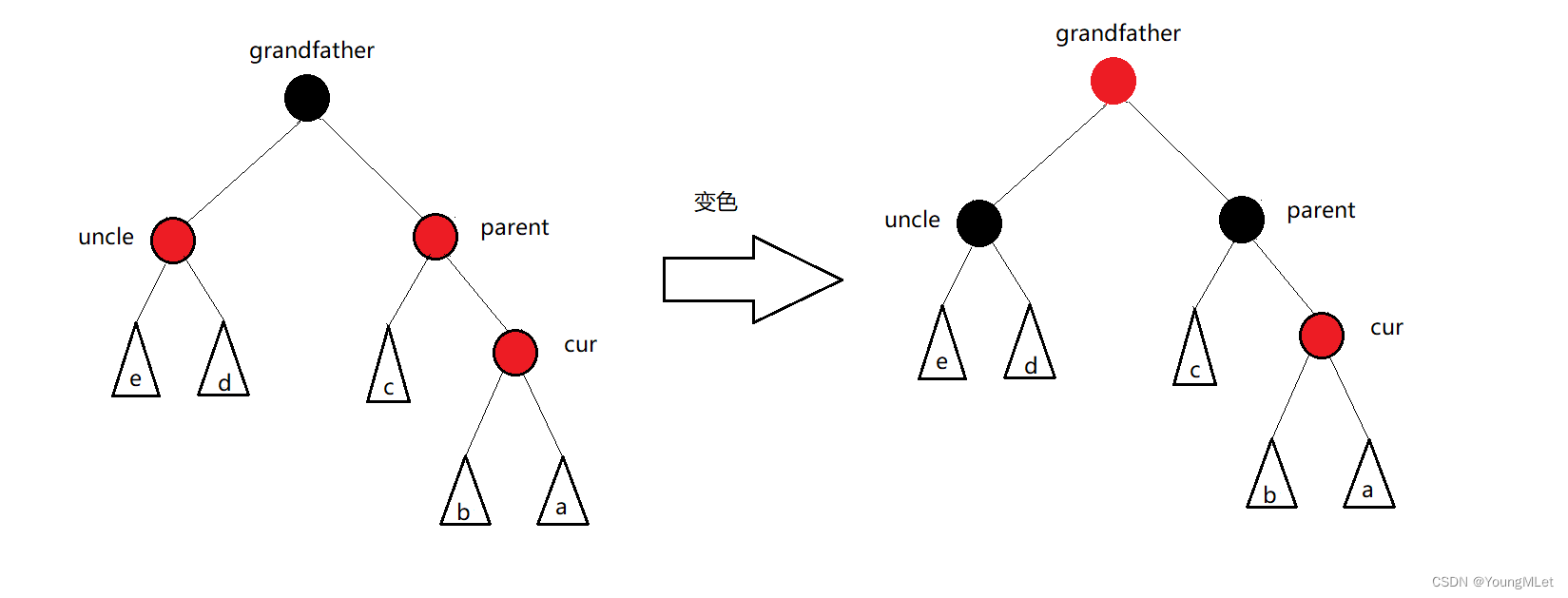
代码如下(续上):
// grandfather->_right == parent// g// u p// celse{Node* uncle = grandfather->_left;// uncle 存在且为红// 不需要旋转if (uncle && uncle->_col == RED){// 变色parent->_col = BLACK;uncle->_col = BLACK;grandfather->_col = RED;// 继续往上处理cur = grandfather;parent = cur->_parent;}}总结:当 uncle 为红色时,解决方案:将 p,u 改为黑,g 改为红,然后把 g 当成 cur,继续向上调整。
情况二: cur 为红,p 为红,g 为黑,u 不存在或者 u 存在且为黑情况2.1,如下图所示,当 p 为 g 的左孩子:
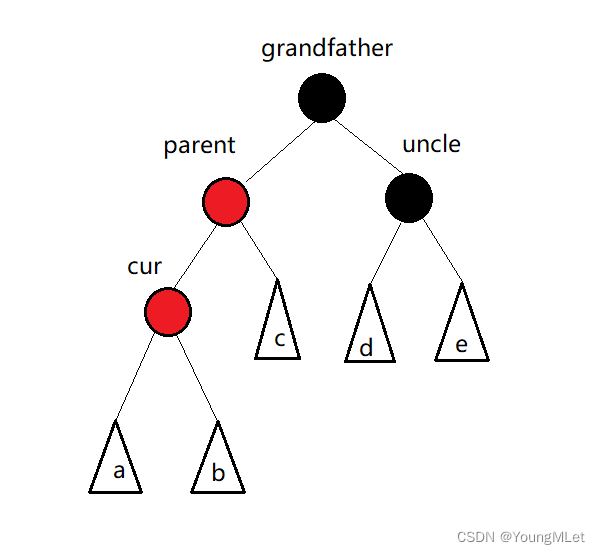
情况2.2,当 p 为 g 的右孩子:
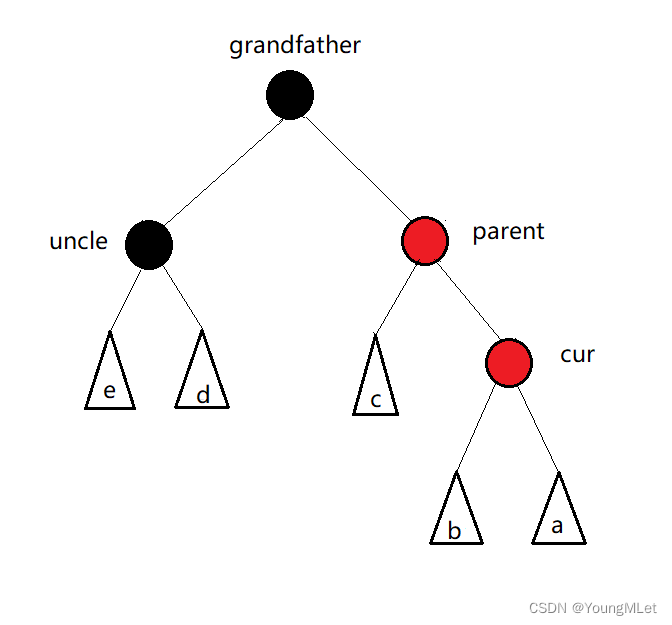
说明:u 的情况有两种:
如果 u 不存在,则 cur 一定是新插入节点,因为如果 cur 不是新插入节点,则 cur 和 p 一定有一个节点的颜色是黑色,就不满足红黑树的性质4:每条路径黑色节点个数相同;如果 u 存在,则其一定是黑色的,那么 cur 节点原来的颜色一定是黑色的,现在看到其是红色的原因是因为 cur 的子树在调整过程中将 cur 节点的颜色由黑色改成了红色。上面的情况2.1和情况2.2需要旋转处理,因为这两种情况本质上是相同的,所以下面只看情况2.1的旋转过程,情况2.2相反即可:
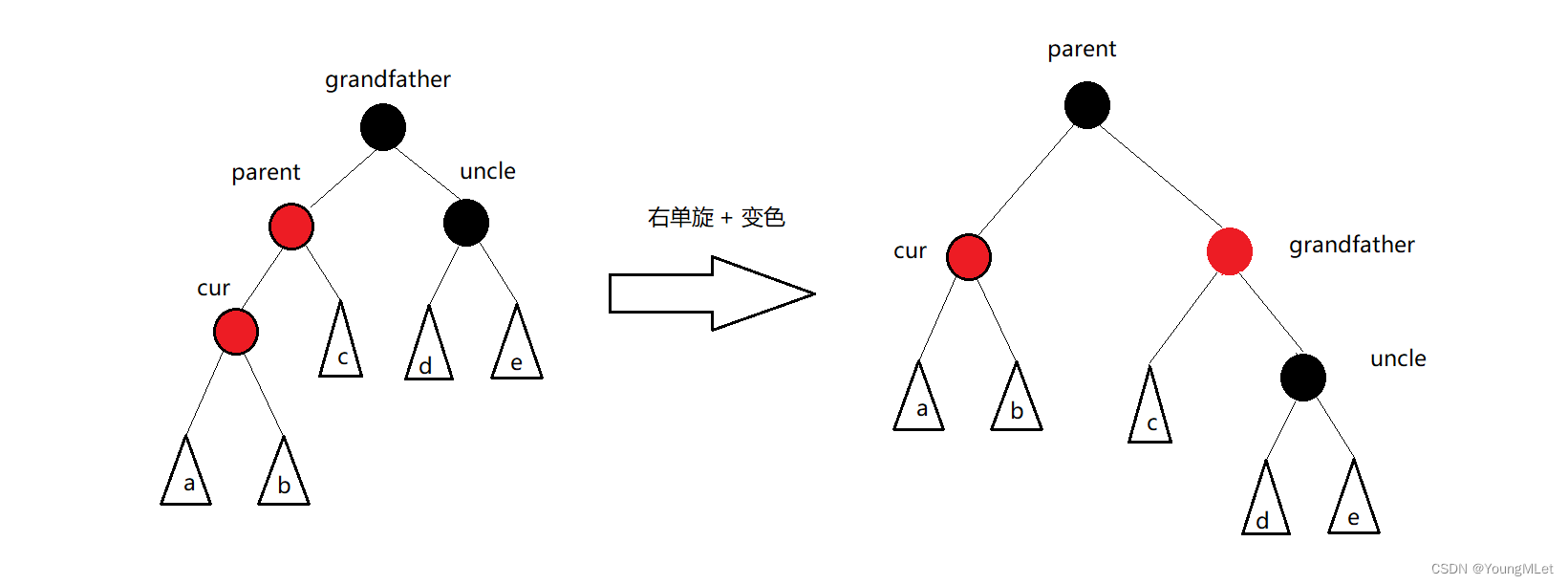
代码如下:
情况2.1
// 单旋// g// p u// cif (cur == parent->_left){RotateR(grandfather);parent->_col = BLACK;grandfather->_col = RED;}情况2.2
// 单旋// g// u p // cif (cur == parent->_right){RotateL(grandfather);parent->_col = BLACK;grandfather->_col = RED;}总结,情况二的解决方案:p 为 g 的左孩子,cur 为 p 的左孩子,则进行右单旋转;相反,p 为 g 的右孩子,cur 为 p 的右孩子,则进行左单旋转;p、g变色- -p变黑,g变红。
情况三: cur 为红,p 为红,g 为黑,u 不存在或者 u 存在且为黑情况三与情况二的不同在于:例如下面的情况3.1,cur 是在 p 的右子树,而情况2.1中 cur 是在 p 的左子树:
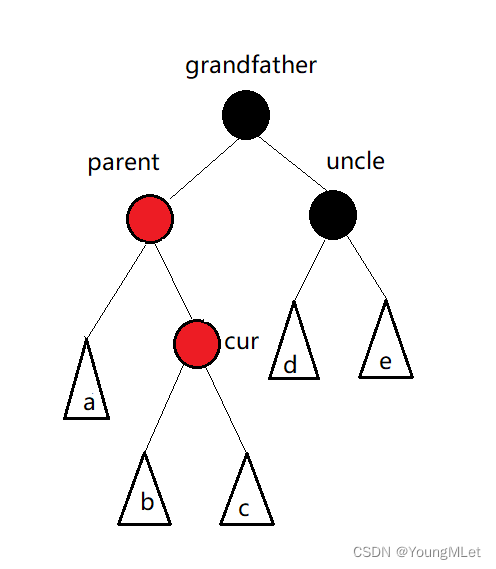
情况3.2:
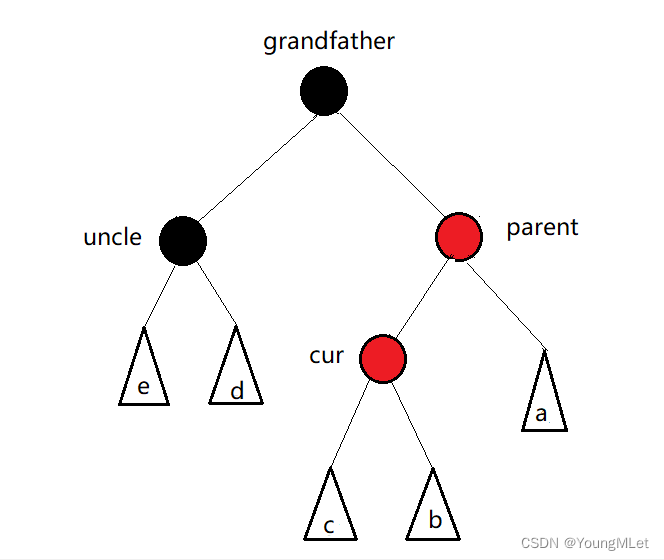
此时这种情况相当于AVL树中双旋的情况,cur 到 g 是折线的形式,在红黑树中这种情况确实也是需要进行双旋,下面只画出情况3.1的旋转过程和变色,情况3.2也是类似的;旋转过程是先对 p 进行左单旋,再对 g 进行右单旋:
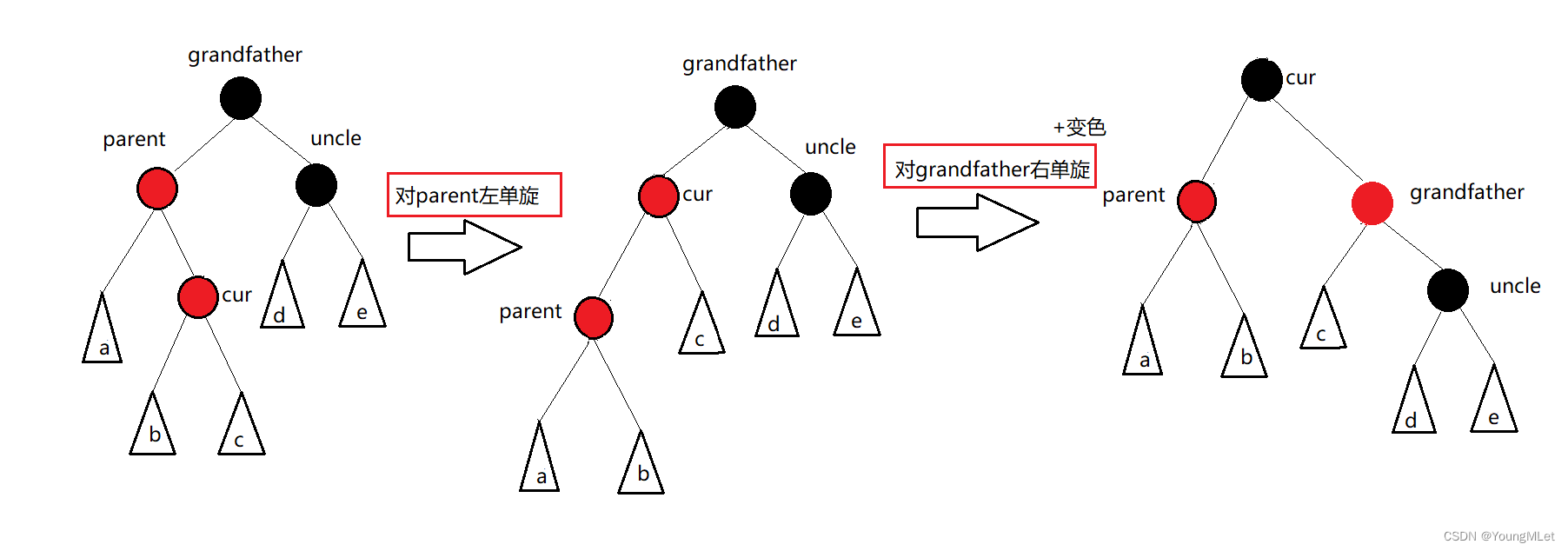
双旋完成后将 cur 变成黑色,g 变成红色;完成更新,跳出循环。
代码如下(续上):
情况3.1
// 双旋// g// p u// celse{RotateL(parent);RotateR(grandfather);cur->_col = BLACK;grandfather->_col = RED;}情况3.2
// 双旋// g// u p // celse{RotateR(parent);RotateL(grandfather);cur->_col = BLACK;grandfather->_col = RED;}总结:p 为 g 的左孩子,cur 为 p 的右孩子,则针对 p 做左单旋转,然后对 g 做右单旋 + 变色;相反,p 为 g 的右孩子,cur 为 p 的左孩子,则针对 p 做右单旋转,然后对 g 做左单旋 + 变色。
完整的插入代码如下:
bool Insert(const pair<K, V>& kv){if (_root == nullptr){_root = new Node(kv);_root->_col = BLACK;return true;}// 找到插入位置Node* cur = _root, *parent = nullptr;while (cur){if (cur->_kv.first > kv.first){parent = cur;cur = cur->_left;}else if (cur->_kv.first < kv.first){parent = cur;cur = cur->_right;}else{return false;}}cur = new Node(kv);if (parent->_kv.first > cur->_kv.first){parent->_left = cur;}else{parent->_right = cur;}cur->_parent = parent;while (parent && parent->_col == RED){Node* grandfather = parent->_parent;// g// p u// cif (grandfather->_left == parent){Node* uncle = grandfather->_right;// 情况1、uncle 存在且为红// 不需要旋转if (uncle && uncle->_col == RED){// 变色parent->_col = BLACK;uncle->_col = BLACK;grandfather->_col = RED;// 继续往上更新处理cur = grandfather;parent = cur->_parent;}else{// 情况2.1// 单旋// g// p// cif (cur == parent->_left){RotateR(grandfather);parent->_col = BLACK;grandfather->_col = RED;}// 情况3.1// 双旋// g// p// celse{RotateL(parent);RotateR(grandfather);cur->_col = BLACK;grandfather->_col = RED;}break;}}// grandfather->_right == parent// g// u p// celse{Node* uncle = grandfather->_left;// uncle 存在且为红// 不需要旋转if (uncle && uncle->_col == RED){// 变色parent->_col = BLACK;uncle->_col = BLACK;grandfather->_col = RED;// 继续往上处理cur = grandfather;parent = cur->_parent;}// uncle 存在且为黑 或者 uncle 不存在else{// 情况2.2// 单旋// g// u p // cif (cur == parent->_right){RotateL(grandfather);parent->_col = BLACK;grandfather->_col = RED;}// 情况3.2// 双旋// g// u p // celse{RotateR(parent);RotateL(grandfather);cur->_col = BLACK;grandfather->_col = RED;}break;}}}// 最后保证根节点是黑色的_root->_col = BLACK;return true;}4. 红黑树的验证
红黑树的检测分为两步:
检测其是否满足二叉搜索树(中序遍历是否为有序序列)检测其是否满足红黑树的性质首先我们验证是否满足二叉搜索树,代码如下:
// 判断中序遍历是否为有序序列void Inorder(){_Inorder(_root);cout << endl;}// 按中序遍历打印树的节点void _Inorder(Node* root){if (root == nullptr)return;_Inorder(root->_left);cout << root->_kv.first << " ";_Inorder(root->_right);}其次判断其是否满足红黑树的性质:
// 判断是否平衡bool IsBalance(){if (_root == nullptr)return true;if (_root->_col == RED)return false;// 先统计一条路径的黑色节点,与其它路径的比较int refVal = 0;Node* cur = _root;while (cur){if (cur->_col == BLACK){refVal++;}cur = cur->_left;}int blacknum = 0;return Check(_root, blacknum, refVal);}// 检查是否符合红黑树规则bool Check(Node* root, int blacknum, int refVal){if (root == nullptr){if (blacknum != refVal){cout << "存在黑色节点数量不相等的路径" << endl;return false;}return true;}if (root->_col == RED && root->_parent->_col == RED){cout << "有连续的红色节点" << endl;return false;}if (root->_col == BLACK){blacknum++;}return Check(root->_left, blacknum, refVal)&& Check(root->_right, blacknum, refVal);}下面我们随机插入一些数验证我们的红黑树是否正常,我们直接插入 1w 个数据,代码如下:
int main(){const int N = 10000;vector<int> v;v.reserve(N);srand(time(0));for (size_t i = 0; i < N; i++)v.push_back(rand() + i);RBTree<int, int> t;for (auto e : v)t.Insert(make_pair(e, e));t.Inorder();if (t.IsBalance())cout << "红黑树正常" << endl;elsecout << "红黑树异常" << endl;return 0;}执行结果如下:
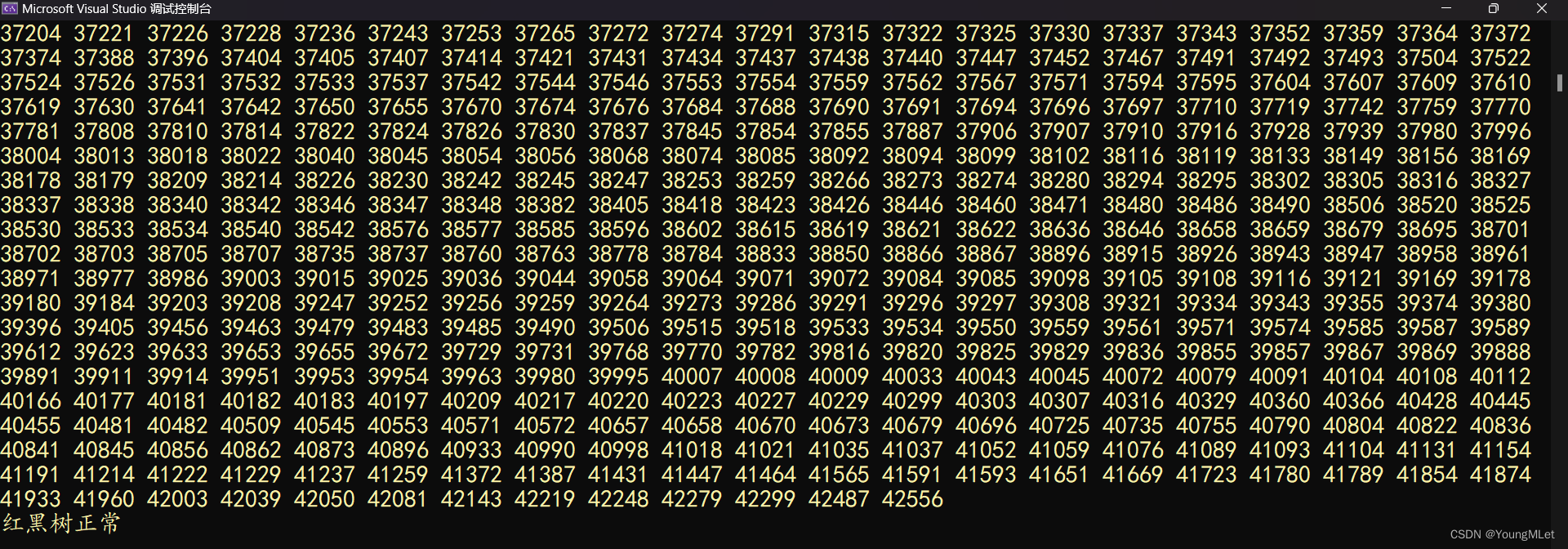
如上图,验证了我们的红黑树是正常的。
5. 红黑树相关的接口方法
下面给出红黑树相关的完整接口代码,包括插入、查找、获取高度、判平衡等;代码如下:
#pragma once#include <iostream>using namespace std;enum COLOUR{RED,BLACK};template<class K, class V>struct RBTreeNode{RBTreeNode<K, V>* _parent;RBTreeNode<K, V>* _left;RBTreeNode<K, V>* _right;COLOUR _col;pair<K, V> _kv;RBTreeNode(const pair<K, V>& kv):_parent(nullptr),_left(nullptr),_right(nullptr),_kv(kv),_col(RED){}};template<class K, class V>class RBTree{typedef RBTreeNode<K, V> Node;public:bool Insert(const pair<K, V>& kv){if (_root == nullptr){_root = new Node(kv);_root->_col = BLACK;return true;}// 找到插入位置Node* cur = _root, *parent = nullptr;while (cur){if (cur->_kv.first > kv.first){parent = cur;cur = cur->_left;}else if (cur->_kv.first < kv.first){parent = cur;cur = cur->_right;}else{return false;}}cur = new Node(kv);if (parent->_kv.first > cur->_kv.first){parent->_left = cur;}else{parent->_right = cur;}cur->_parent = parent;while (parent && parent->_col == RED){Node* grandfather = parent->_parent;// g// p u// cif (grandfather->_left == parent){Node* uncle = grandfather->_right;// 情况1、uncle 存在且为红// 不需要旋转if (uncle && uncle->_col == RED){// 变色parent->_col = BLACK;uncle->_col = BLACK;grandfather->_col = RED;// 继续往上更新处理cur = grandfather;parent = cur->_parent;}else{// 情况2.1// 单旋// g// p// cif (cur == parent->_left){RotateR(grandfather);parent->_col = BLACK;grandfather->_col = RED;}// 情况3.1// 双旋// g// p// celse{RotateL(parent);RotateR(grandfather);cur->_col = BLACK;grandfather->_col = RED;}break;}}// grandfather->_right == parent// g// u p// celse{Node* uncle = grandfather->_left;// uncle 存在且为红// 不需要旋转if (uncle && uncle->_col == RED){// 变色parent->_col = BLACK;uncle->_col = BLACK;grandfather->_col = RED;// 继续往上处理cur = grandfather;parent = cur->_parent;}// uncle 存在且为黑 或者 uncle 不存在else{// 情况2.2// 单旋// g// u p // cif (cur == parent->_right){RotateL(grandfather);parent->_col = BLACK;grandfather->_col = RED;}// 情况3.2// 双旋// g// u p // celse{RotateR(parent);RotateL(grandfather);cur->_col = BLACK;grandfather->_col = RED;}break;}}}// 最后保证根节点是黑色的_root->_col = BLACK;return true;}// 判断中序遍历是否为有序序列void Inorder(){_Inorder(_root);cout << endl;}// 判断是否平衡bool IsBalance(){if (_root == nullptr)return true;if (_root->_col == RED)return false;// 先统计一条路径的黑色节点,与其它路径的比较int refVal = 0;Node* cur = _root;while (cur){if (cur->_col == BLACK){refVal++;}cur = cur->_left;}int blacknum = 0;return Check(_root, blacknum, refVal);}// 获取树的高度int Height(){return _Height(_root);}// 获取树的节点数size_t Size(){return _Size(_root);}// 查找Node* Find(const K& key){Node* cur = _root;while (cur){if (cur->_kv.first < key){cur = cur->_right;}else if (cur->_kv.first > key){cur = cur->_left;}else{return cur;}}return NULL;}private:// 获取树的节点个数size_t _Size(Node* root){if (root == NULL)return 0;return _Size(root->_left)+ _Size(root->_right) + 1;}// 获取树的高度int _Height(Node* root){if (root == nullptr)return 0;int leftHeight = _Height(root->_left);int rightHeight = _Height(root->_right);return leftHeight > rightHeight ? leftHeight + 1 : rightHeight + 1;}// 检查是否符合红黑树规则bool Check(Node* root, int blacknum, int refVal){if (root == nullptr){if (blacknum != refVal){cout << "存在黑色节点数量不相等的路径" << endl;return false;}return true;}if (root->_col == RED && root->_parent->_col == RED){cout << "有连续的红色节点" << endl;return false;}if (root->_col == BLACK){blacknum++;}return Check(root->_left, blacknum, refVal)&& Check(root->_right, blacknum, refVal);}// 按中序遍历打印树的节点void _Inorder(Node* root){if (root == nullptr)return;_Inorder(root->_left);cout << root->_kv.first << " ";_Inorder(root->_right);}// 左单旋void RotateL(Node* parent){Node* subR = parent->_right, * subRL = subR->_left;parent->_right = subRL;if (subRL)subRL->_parent = parent;subR->_left = parent;Node* parentParent = parent->_parent;parent->_parent = subR;// 如果 parent 是根节点,就直接更新 subR 为根节点,并将 subR 的_parent指向空if (_root == parent){_root = subR;subR->_parent = nullptr;}// 否则,先判断 parent 是 parentParent 的右还是左,再将parentParent的左或者右连接subRelse{if (parentParent->_left == parent){parentParent->_left = subR;}else{parentParent->_right = subR;}subR->_parent = parentParent;}}// 右单旋void RotateR(Node* parent){Node* subL = parent->_left, * subLR = subL->_right;parent->_left = subLR;if (subLR)subLR->_parent = parent;subL->_right = parent;Node* parentParent = parent->_parent;parent->_parent = subL;if (_root == parent){_root = subL;subL->_parent = nullptr;}else{if (parentParent->_left == parent){parentParent->_left = subL;}else{parentParent->_right = subL;}subL->_parent = parentParent;}}private:Node* _root = nullptr;};三、用红黑树封装 map/set
1. 红黑树的迭代器
迭代器的好处是可以方便遍历,是数据结构的底层实现与用户透明。如果想要给红黑树增加迭代器,需要考虑以前问题:
begin()与end()STL明确规定,begin() 与 end() 代表的是一段前闭后开的区间,而对红黑树进行中序遍历后,可以得到一个有序的序列,因此:begin() 可以放在红黑树中最小节点(即最左侧节点)的位置,end() 放在最大节点(最右侧节点)的下一个位置,关键是最大节点的下一个位置在哪块?能否给成 nullptr 呢?答案是行不通的,因为对 end() 位置的迭代器进行 - - 操作,必须要能找最后一个元素,此处就不行,因此最好的方式是将 end() 放在头结点的位置;但是我们为了方便,将 end() 给成 nullptr.
operator++()与operator–()迭代器最重要的部分就是在 ++ 和 - - 的实现上;先说 ++it 的核心,因为我们是要按照中序的顺序遍历红黑树,所以 ++it 最核心的就是找中序的下一个,此时分为两种情况:1. it 指向的节点,如果右子树不为空,下一个就是右子树的最左节点;2. it 指向的节点,如果右子树为空,表明 it 中的节点所在的子树访问完了,往上找孩子是父亲左的那个祖先;
再简单说一下 - -,- - 的实现与 ++ 反过来,分两种情况:1. 左不为空,下一个就是左子树的最右节点;2. 左为空,往上找孩子是父亲右的那个祖先;
如下为红黑树迭代器的代码示例:
template<class T, class Ref, class Ptr>struct __TreeIterator{typedef RBTreeNode<T> Node;typedef __TreeIterator<T, Ref, Ptr> Self;Node* _node;__TreeIterator(Node* node):_node(node){}Ref operator*(){return _node->_data;}Ptr operator->(){return &_node->_data;}bool operator!=(const Self& s){return _node != s._node;}bool operator==(const Self& s){return _node == s._node;}// 前置--Self& operator--(){if (_node->_left){Node* cur = _node->_left;while (cur->_right){cur = cur->_right;}_node = cur;}else{Node* cur = _node, * parent = cur->_parent;while (parent && parent->_right != cur){cur = parent;parent = parent->_parent;}_node = parent;}return *this;}// 前置++Self& operator++(){if (_node->_right){Node* cur = _node->_right;while (cur->_left){cur = cur->_left;}_node = cur;}else{Node* cur = _node, * parent = cur->_parent;while (parent && cur != parent->_left){cur = parent;parent = cur->_parent;}_node = parent;}return *this;}};2. 改造红黑树
因为关联式容器中存储的是 <key, value> 的键值对,因此,K 为 key 的类型,T:如果是 map,则为 pair<K, V>;如果是 set,则为 K;所以在封装 map/set 的时候,第二个模板参数就决定了树的节点是什么类型,如下图转换过程:
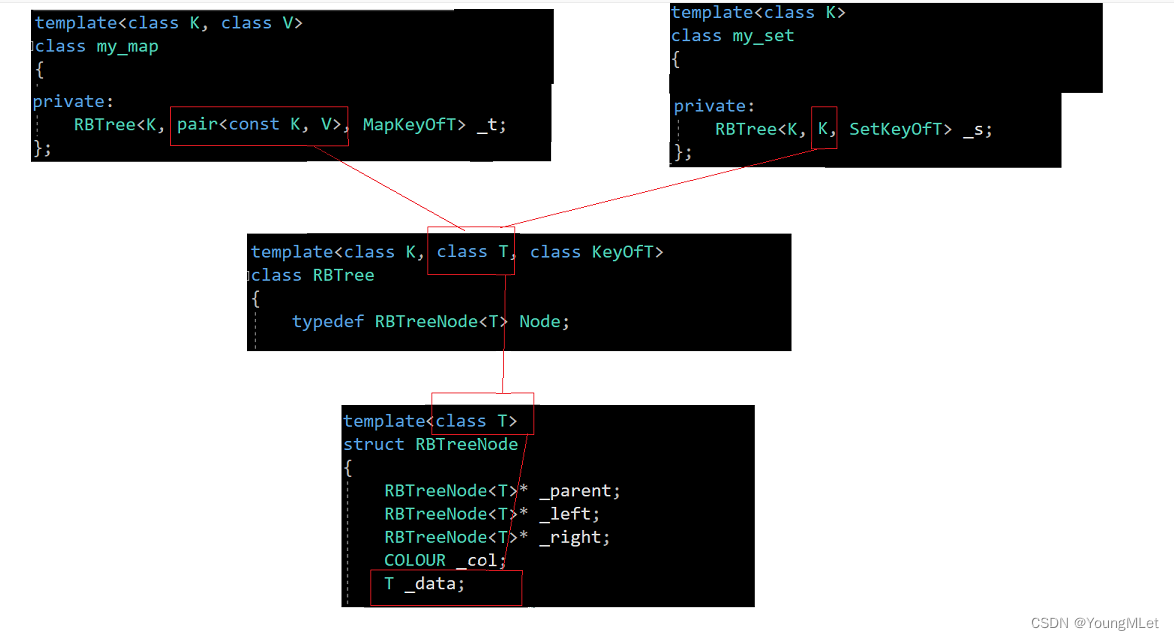
那么第二个问题来了,我们在插入节点的时候,可以使用 T 作为参数类型,如下图;

那么在比较的时候应该怎么比较呢?我们怎么知道这个 T 是 map 的 pair 类型 还是 set 的 K 类型 呢?所以这里需要在 map/set 中提供一个仿函数,来获取各自的数据类型,再进行比较;如下图转换过程:
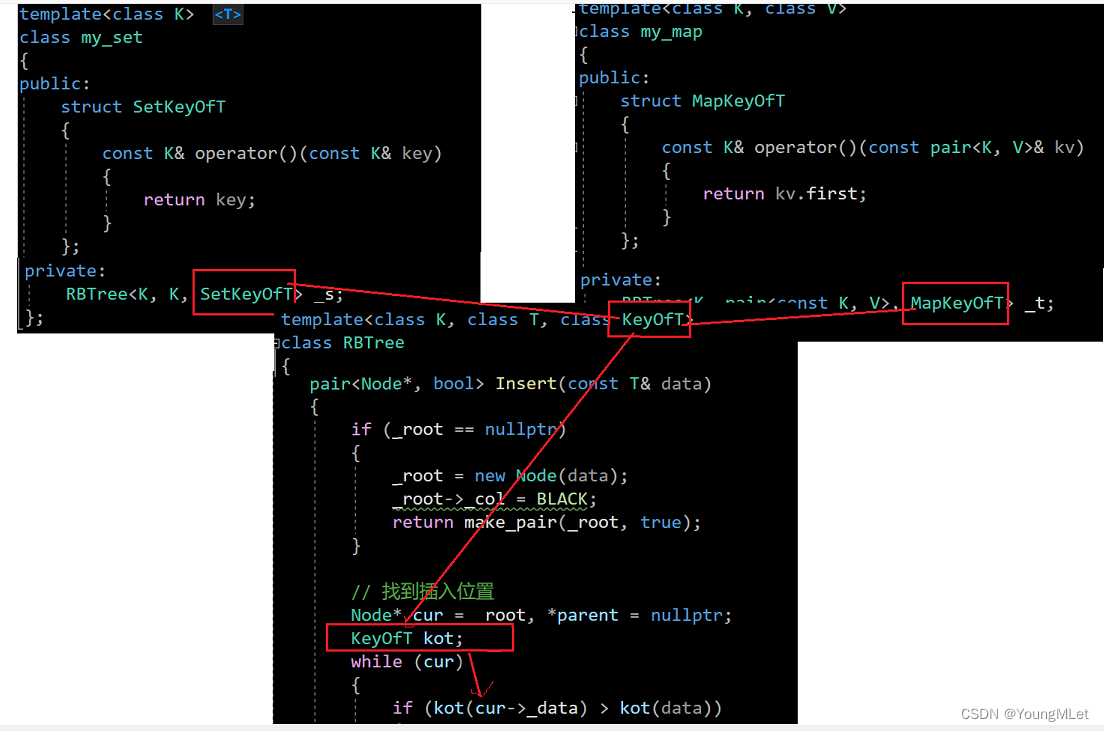
那么 set 只有一个类型为什么还要写一个仿函数提取 key 呢?因为 set 的底层也是红黑树,为了保证红黑树的底层兼容 map,set 只能也写仿函数了,因为 map 是要仿函数获取类型的。
经过改造的红黑树的参考代码如下:
enum COLOUR{RED,BLACK};template<class T>struct RBTreeNode{RBTreeNode<T>* _parent;RBTreeNode<T>* _left;RBTreeNode<T>* _right;COLOUR _col;T _data;RBTreeNode(const T& data):_parent(nullptr),_left(nullptr),_right(nullptr),_data(data),_col(RED){}};template<class T, class Ref, class Ptr>struct __TreeIterator{typedef RBTreeNode<T> Node;typedef __TreeIterator<T, Ref, Ptr> Self;Node* _node;__TreeIterator(Node* node):_node(node){}Ref operator*(){return _node->_data;}Ptr operator->(){return &_node->_data;}bool operator!=(const Self& s){return _node != s._node;}bool operator==(const Self& s){return _node == s._node;}// 前置--Self& operator--(){if (_node->_left){Node* cur = _node->_left;while (cur->_right){cur = cur->_right;}_node = cur;}else{Node* cur = _node, * parent = cur->_parent;while (parent && parent->_right != cur){cur = parent;parent = parent->_parent;}_node = parent;}return *this;}// 前置++Self& operator++(){if (_node->_right){Node* cur = _node->_right;while (cur->_left){cur = cur->_left;}_node = cur;}else{Node* cur = _node, * parent = cur->_parent;while (parent && cur != parent->_left){cur = parent;parent = cur->_parent;}_node = parent;}return *this;}};template<class K, class T, class KeyOfT>class RBTree{typedef RBTreeNode<T> Node;public:typedef __TreeIterator<T, T&, T*> iterator;typedef __TreeIterator<T, const T&, const T*> const_iterator;iterator begin(){Node* cur = _root;while (cur && cur->_left){cur = cur->_left;}return iterator(cur);}iterator end() {return iterator(nullptr);}const_iterator begin() const{Node* cur = _root;while (cur && cur->_left){cur = cur->_left;}return const_iterator(cur);}const_iterator end() const{return const_iterator(nullptr);}pair<Node*, bool> Insert(const T& data){if (_root == nullptr){_root = new Node(data);_root->_col = BLACK;return make_pair(_root, true);}// 找到插入位置Node* cur = _root, *parent = nullptr;KeyOfT kot;while (cur){if (kot(cur->_data) > kot(data)){parent = cur;cur = cur->_left;}else if (kot(cur->_data) < kot(data)){parent = cur;cur = cur->_right;}else{return make_pair(cur, false);}}cur = new Node(data);Node* newnode = cur;if (kot(parent->_data) > kot(cur->_data)){parent->_left = cur;}else{parent->_right = cur;}cur->_parent = parent;while (parent && parent->_col == RED){Node* grandfather = parent->_parent;// g// p u// cif (grandfather->_left == parent){Node* uncle = grandfather->_right;// 情况1、uncle 存在且为红// 不需要旋转if (uncle && uncle->_col == RED){// 变色parent->_col = BLACK;uncle->_col = BLACK;grandfather->_col = RED;// 继续往上更新处理cur = grandfather;parent = cur->_parent;}else{// 情况2.1// 单旋// g// p// cif (cur == parent->_left){RotateR(grandfather);parent->_col = BLACK;grandfather->_col = RED;}// 情况3.1// 双旋// g// p// celse{RotateL(parent);RotateR(grandfather);cur->_col = BLACK;grandfather->_col = RED;}break;}}// grandfather->_right == parent// g// u p// celse{Node* uncle = grandfather->_left;// uncle 存在且为红// 不需要旋转if (uncle && uncle->_col == RED){// 变色parent->_col = BLACK;uncle->_col = BLACK;grandfather->_col = RED;// 继续往上处理cur = grandfather;parent = cur->_parent;}// uncle 存在且为黑 或者 uncle 不存在else{// 情况2.2// 单旋// g// u p // cif (cur == parent->_right){RotateL(grandfather);parent->_col = BLACK;grandfather->_col = RED;}// 情况3.2// 双旋// g// u p // celse{RotateR(parent);RotateL(grandfather);cur->_col = BLACK;grandfather->_col = RED;}break;}}}// 最后保证根节点是黑色的_root->_col = BLACK;return make_pair(newnode, true);}private:// 左单旋void RotateL(Node* parent){Node* subR = parent->_right, * subRL = subR->_left;parent->_right = subRL;if (subRL)subRL->_parent = parent;subR->_left = parent;Node* parentParent = parent->_parent;parent->_parent = subR;// 如果 parent 是根节点,就直接更新 subR 为根节点,并将 subR 的_parent指向空if (_root == parent){_root = subR;subR->_parent = nullptr;}// 否则,先判断 parent 是 parentParent 的右还是左,再将parentParent的左或者右连接subRelse{if (parentParent->_left == parent){parentParent->_left = subR;}else{parentParent->_right = subR;}subR->_parent = parentParent;}}// 右单旋void RotateR(Node* parent){Node* subL = parent->_left, * subLR = subL->_right;parent->_left = subLR;if (subLR)subLR->_parent = parent;subL->_right = parent;Node* parentParent = parent->_parent;parent->_parent = subL;if (_root == parent){_root = subL;subL->_parent = nullptr;}else{if (parentParent->_left == parent){parentParent->_left = subL;}else{parentParent->_right = subL;}subL->_parent = parentParent;}}private:Node* _root = nullptr;};3. 用红黑树封装 set
以下我们用红黑树封装出一个简单的 set,代码如下:
#pragma once#include "RBTree.h"template<class K>class my_set{public:struct SetKeyOfT{const K& operator()(const K& key){return key;}};public:typedef typename RBTree<K, K, SetKeyOfT>::const_iterator iterator;typedef typename RBTree<K, K, SetKeyOfT>::const_iterator const_iterator;iterator begin() const{return _s.begin();}iterator end() const{return _s.end();}pair<iterator, bool> insert(const K& key){return _s.Insert(key);}private:RBTree<K, K, SetKeyOfT> _s;};我们验证一下 my_set,结果如下:
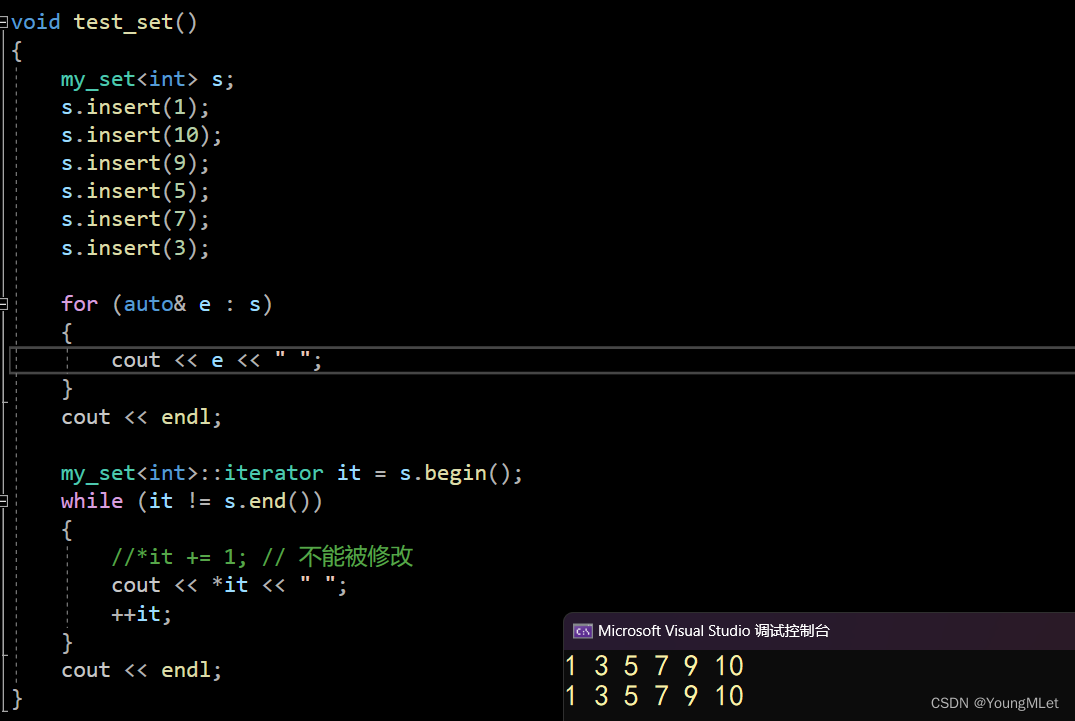
4. 用红黑树封装 map
最后我们用红黑树封装出一个简单的 map,代码如下:
#pragma once#include "RBTree.h"template<class K, class V>class my_map{public:struct MapKeyOfT{const K& operator()(const pair<K, V>& kv){return kv.first;}};public:// 对类模板取内嵌类型,加 typename 告诉编译器这里是类型typedef typename RBTree<K, pair<const K, V>, MapKeyOfT>::iterator iterator;typedef typename RBTree<K, pair<const K, V>, MapKeyOfT>::const_iterator const_iterator;iterator begin(){return _t.begin();}iterator end(){return _t.end();}const_iterator begin() const {return _t.begin();}const_iterator end() const {return _t.end();}V& operator[](const K& key){pair<iterator, bool> ret = insert(make_pair(key, V()));return ret.first->second;}pair<iterator, bool> insert(const pair<K, V>& kv){return _t.Insert(kv);}private:RBTree<K, pair<const K, V>, MapKeyOfT> _t;};对 my_map 进行验证,结果如下:
